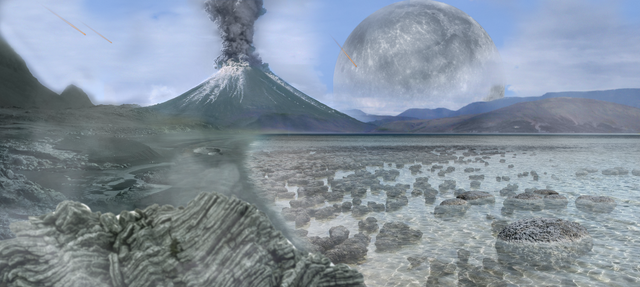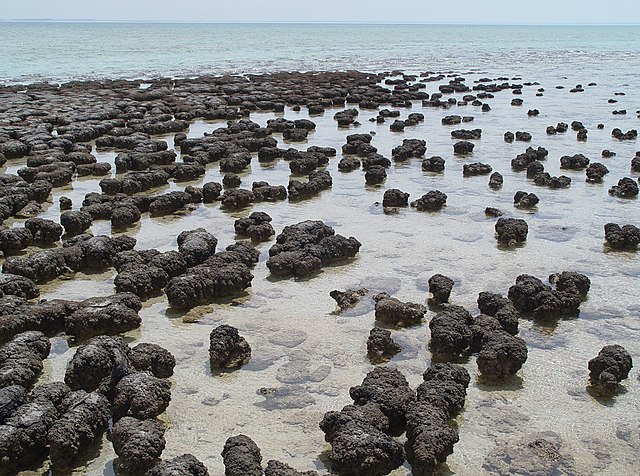
Image 1 Caption: An artist's impression of Archean Eon (4.031--2.5 Gyr BP) on Earth.
We think that microbial life may first appeared on Earth 3.480 Gyr ago at least and perhaps 4.2 Gyr ago (Wikipedia: Earliest known life forms; Robert F. Service, 2014 Jul12, Science "Our last common ancestor lived 4.2 billion years ago" maybe; Wikipedia: Abiogenesis; Wikipedia: History of life on Earth; Wikipedia: History of life on Earth: Earliest history Earth). But we don't know how exactly it arose. But somehow:
-
Life
was thus an almost utterly improbable event with almost infinite
opportunities of happening. So it did.
-
---James Lovelock (1919--2022),
the proposer of the
Gaia hypothesis.
Quotation from Tim Radford, Nature,
2019 Jun25.
Note the 4.2 Gyr value is NOT based on the fossil record, but on a statistical study of genomes that tries to identify and date the last univeral common ancestor (LUCA) of all life on Earth (Robert F. Service, 2014 Jul12, Science "Our last common ancestor lived 4.2 billion years ago" maybe). Well, except maybe viruses (Wikipedia: Last univeral common ancestor (LUCA)).
Features:
- The formation of the Solar System
is about 4.6 Gyr Before Present (PB)
as we know from the
Sun age = 4.6 Gyr BP (set by various methods)
and presolar grains
(Wikipedia: Hadean Eon (4.56730(16)--4.031 Gyr BP:
first date set by first solids formed in presolar nebula);
Solar System age = 4.56730(16) Gyr BP (set by first solids formed in presolar nebula)).
The presolar grains also determine the age of the Earth = 4.56730(16) Gyr BP.
The age of the presolar grains is determined by radioactive dating of primitive meteorites.
- Note the
Hadean Eon (4.56730(16)--4.031 Gyr BP)
is followed by
the Archean Eon (4.031--2.5 Gyr BP),
Proterozoic Eon (2.5--0.5388 Gyr BP),
and
Phanerozoic Eon (0.5388--present Gyr BP).
The
eons
are the
4 eons
of geologic time (4.56730(16)--present BP).
- Image 1 seems to represent the
very early Archean Eon (4.031--2.5 Gyr BP)
since the artist's impression
includes impactors (in the upper
left) which
suggests Image 1 is set in the
heavy bombardment
(4.6--3.8 Gyr BP).
- The volcano in
Image 1 represents
the intense early volcanism
of the early Earth
in the
Hadean Eon (4.56730(16)--4.031 Gyr BP)
and
the Archean Eon (4.031--2.5 Gyr BP)
(Wikipedia: Archean: Geology).
This intense early volcanism
of the early Earth was driven by
the early Earth's
primordial-radiogenic heat geology
which was much stronger than it is today.
- Image 1 gives the impression that
Moon as being
gigantic in the sky.
Now the angular size of the Moon
in any image is, in fact, rather indeterminate since it depends on the
angular size of the surroundings.
For example, if the angular size of the volcano
were ∼0.5°, the
Moon would have
about the same
angular diameter as it does today.
However, Image 1 does convey the correct qualitative impression. At ∼4 Gyr BP, Moon was probably of order 10 times closer than today, and so would have an angular diameter of order 10 times bigger than today: i.e., ∼5° (Wikipedia: Origin of the Moon: Formation). Tidal accelertation caused the Moon to slowly spiral away from the Earth. Currently, the Earth-Moon distance is increasing by 3.830(8) cm/yr (Wikipedia: Tidal acceleration: Quantitative description of the Earth-Moon case).
- Probably rather quickly ??? after the
Moon's formation (maybe 4.425 Gyr BP),
the Moon became
tidally locked to the
Earth causing the
Moon to always turn the same
side to the Earth.
This side is the
Moon's near side.
The Moon's near side
would have looked rather different in the
earlier Archean Eon (4.031--2.5 Gyr BP)
than today since there was continuing heavy
impact cratering
by the
heavy bombardment
(4.6--3.8 Gyr BP)
and the lunar maria
were only in their early stage of formation
(Wikipedia: Lunar mare: Ages).
- The water body
in the foreground of Image 1 shows
stromatolites which
may be one of the earliest signs of
life on
Earth which are currently known as early
as 3.48 Gyr BP, but they may have existed much earlier
(Wikipedia:
Earliest known life forms: Stromatolites: see also
Wikipedia: Earliest known life forms;
Robert F. Service,
2014 Jul12, Science "Our last common ancestor lived 4.2 billion years ago" maybe;
Wikipedia: Abiogenesis).
Note "stromatolites are layered sedimentary rock formations (microbialites) that are created mainly by photosynthetic microorganism" (Wikipedia: Stromatolites: slightly edited).

- Image 2 Caption: "Modern stromatolites growing in Hamelin Pool Marine Nature Reserve, Shark Bay, Western Australia, Australia." (Slightly edited.)
- Image 2 Caption: "Modern stromatolites growing in Hamelin Pool Marine Nature Reserve, Shark Bay, Western Australia, Australia." (Slightly edited.)
-
Images:
- Credit/Permission: ©
Tim Bertelink (AKA User:Triangulum),
2017 /
CC BY-SA 4.0.
Image link: Wikimedia Commons: File:Archean.png.
- Credit/Permission: ©
Paul Harrison,
2005
(uploaded to
Wikimedia Commons
Wikipedia
by User:YolanC,
2006) /
CC BY-SA 3.0.
Image link: Wikimedia Commons: File:Stromatolites in Sharkbay.jpg.
File: Biology file: earth_archean_eon.html.